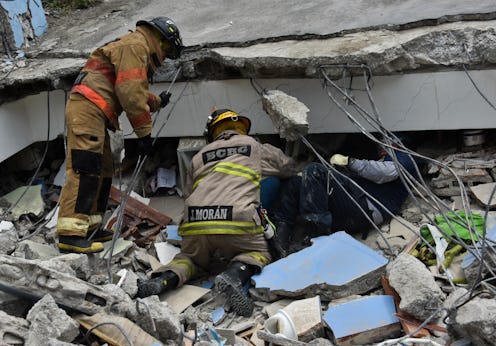News
Heartbreaking Aftermath Of The Ecuador Earthquake
Over 200 deaths and massive destruction remains in the aftermath of the Ecuador earthquake that struck the small South American country on Saturday. The 7.8 magnitude quake and the subsequent series of aftershocks is among the worst the country has faced since 1979 when the Tumaco earthquake, named after its epicenter near the port city of Tumaco, Colombia, killed over 600 Ecuadorians and injured more than 20,000. The death toll for Saturday's quake is not yet finalized and could continue to rise for several days as rescue efforts continue.
Emergency response efforts are underway in the areas most heavily effected, including the cities of Guayaquil, Quito, and Pedernales. In Guayaquil, the country's most populous city, many citizens slept in the streets or worked through the night helping those trapped in the rubble. A video of a bridge that collapsed onto a car on one of Guayaquil's busiest streets showed dozens of men working together to help the victims. Vice president Jorge Glas told reporters that 10,000 military troops and several thousand police officers have been dispatched to the cities, as well as the coastal region, and $600 million in credit was made available for the rescue efforts.
Experts have commented on two important parallels between the recent quakes in Japan and the Ecuadorian earthquake, saying they are not connected, but Ecuador could learn from Japan. According to the U.S. Geological Survey, there is no direct connection between the two quakes. Although both countries are located on the "Ring of Fire," a seismically active area in the Pacific Ocean, they were too far apart to have been caused by the same plate shift. "Even the earth's rocky crust is not rigid enough to transfer stress efficiently over thousands of miles," the USGS posted on its website.
However, Ecuador may want to strive to follow Japan's example in its rebuilding efforts. According to David Rothery, a professor of planetary geosciences at The Open University in England, Ecuador's earthquake, while more destructive, was actually less powerful than Japan's, where less than 50 people died in two quakes on Thursday and Saturday. Rothery told NBC News that the quake in Ecuador started deeper underground than the quakes in Japan, meaning they should have caused less shaking and surface damage. But due to Ecuador's less rigorous building codes, Ecuador suffered from worse infrastructure damage and greater loss of life.
As the physical aftermath of the earthquake subsides, its impact on the country's social and economic status could be debilitating for its citizens, over 20 percent of whom live below the poverty line. Find out how you can help the victims of the Ecuador earthquake here.
